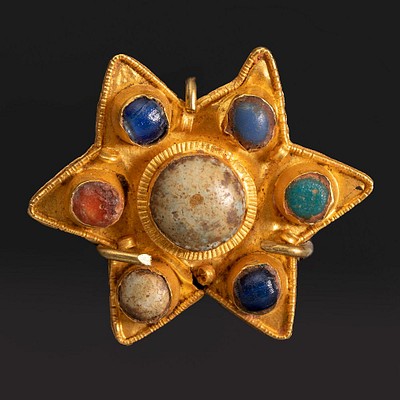JOSÉ GARNELO Y ALDA (Enguera, 1866 - Montilla, 1944). "Andalusian Scene". Oil on panel.
Lot 111
About Seller
Setdart Auction House
Carrer Aragó 346
Barcelona
Spain
Setdart Subastas was born in 2004 and is currently the first online art auction in Spain with solidity, prestige and reliability guaranteed by our more than 60,000 users. Setdart has a young, dynamic and enterprising team ready to successfully manage the purchase and sale of art works through custom...Read more
Estimate:
EUR€2,500 - EUR€3,000
$2,688.17 - $3,225.81
Absentee vs Live bid
Two ways to bid:
- Leave a max absentee bid and the platform will bid on your behalf up to your maximum bid during the live auction.
- Bid live during the auction and your bids will be submitted real-time to the auctioneer.
Bid Increments
| Price | Bid Increment |
|---|---|
| EUR€0 | EUR€10 |
| EUR€200 | EUR€25 |
| EUR€500 | EUR€50 |
| EUR€1,000 | EUR€100 |
| EUR€3,000 | EUR€200 |
| EUR€5,000 | EUR€500 |
| EUR€10,000 | EUR€1,000 |
| EUR€20,000 | EUR€2,000 |
| EUR€50,000 | EUR€5,000 |
About Auction
By Setdart Auction House
Dec 21, 2021
Set Reminder
2021-12-21 07:30:00
2021-12-21 07:30:00
America/New_York
Bidsquare
Bidsquare : Córdoba: 2,000 Years of Art
https://www.bidsquare.com/auctions/setdart-auction-house/c-rdoba-2-000-years-of-art-8049
Setdart Auction House sofia@setdart.com
Setdart Auction House sofia@setdart.com
- Lot Description
JOSÉ GARNELO Y ALDA (Enguera, 1866 - Montilla, 1944). "Andalusian Scene". Oil on panel. Signed in the lower right area. Measurements: 32 x 31 cm; 48.5 x 47.5 cm (frame). This work is framed within the Andalusian costumbrismo of the 19th century, showing an intimate scene, whose protagonist is a young woman dressed as a flamenco girl holding a Spanish guitar in her hands. The scene is completed with the presence of a man, who approaches the young woman from behind, without her paying attention to his presence.The new 19th century costumbrismo painting was born as a way of interpreting a growing sense of national consciousness, now present in the middle class as it moved towards social hegemony. To a certain extent, the painters' concern was to deepen the vision of their country through a language, that of painting, that everyone could understand, thus helping the common people to understand the nature and meaning of their nationality, especially as it had manifested itself in the recent past, still alive in the memory of the elders. Of the two fundamental costumbrista schools of 19th century Spain, the one from Seville and the one from Madrid, the latter differs from the gentle picturesqueness of the former in its more pungent and harsh vision, sometimes going so far as to show not only the vulgar, but even recreating itself in torn visions of a clichéd world of the slums, in which the spirit of criticism is evident. José Santiago Garnelo began his training in Montilla and Cabra, to finally enter the Academia de Bellas Artes de San Fernando, in Madrid, where he was an outstanding disciple of Castro Plasencia. During his time as a student he received several awards, such as the Colorido Medal in the 1885-85 academic year, and in 1888 he obtained a scholarship to Rome. In the Italian capital he will have as companions Sorolla and Villegas Cordero, among others. Once back in Spain, in 1893 he was appointed professor at the School of Fine Arts in Zaragoza, beginning a brilliant teaching career that would later take him to the Schools of Fine Arts in Cadiz and Barcelona, the latter city where he counted Pablo Picasso among his students. He was appointed academician of San Fernando in 1912, and three years later he was appointed deputy director of the Prado Museum. Also, from 1936 he directed the Spanish Academy in Rome. Garnelo sent his works to the National Exhibitions of Fine Arts, being awarded the second medal in 1877 and 1890 and the first in 1892. He also won the competition of the Royal Academy of San Fernando in 1894, and won an honorable mention at the Paris Salon in 1896 and a gold medal at the National Exhibition in Valencia in 1910. At the same time, he held exhibitions in the main Spanish capitals, as well as in Paris, London, Berlin and Chicago. He is currently represented in the Fine Arts Museums of Valencia and Seville, the one that bears his name in Montilla, the Aranjuez Palace in Madrid and the Naval Museum of the same city, among other public and private collections.
- Shipping Info
-
In-house shipping available. Please inquire at admin@setdart.com.
-
- Buyer's Premium



 EUR
EUR CAD
CAD AUD
AUD GBP
GBP MXN
MXN HKD
HKD CNY
CNY MYR
MYR SEK
SEK SGD
SGD CHF
CHF THB
THB














